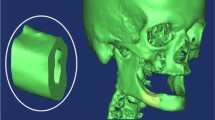Abstract
A key factor for the success or failure of a dental implant is the manner in which stresses are transferred to the surrounding bone. This depends on the type of loading, bone–implant interface, the shape and characteristics of the implant surface and the quality and quantity of the surrounding bone. This study was done to evaluate the pattern of stress distribution with two different implant designs in four different densities of bone using 3D finite element analysis. Graphic pre-processing software Ansys version 10 was used for creating the geometric configuration of a section of the mandible with a missing first molar. Eight 3D models of this section restored with implant-supported all ceramic crowns were created. Four of these models were created to simulate a single threaded implant placed in four different densities of bone (D1, D2, D3 and D4). The other four models were created to simulate a single cylindrical implant placed in four different densities of bone (D1, D2, D3, and D4). The Poisson’s ratio (μ) and Young’s modulus (E) of elasticity of the material were incorporated into the model. An average vertical load of 400 N was applied on the occlusal surface of the first molar between the buccal cusp, central fossa and the marginal ridge. Maximum Von Mises stresses in all the eight models were observed at the crestal region or neck of the implant. The stresses observed were more for the threaded implants in all the four densities of bone when compared to that of the cylindrical implants. The study concluded that the cylindrical implant design was more favorable in softer bone than the threaded implant design.






Similar content being viewed by others
References
Lee JH, Fria V, Lee KW, Wright RF (2005) Effect of implant size and shape on implant success rate: a literature review. J Prosthet Dent 94:377–381
Sevimay M, Turhan F (2005) Three-dimensional finite element analysis on the effect of different bone quality on stress distribution in implant-supported crown. J Prosthet Dent 93:227–233
Geng JP, Tan KBC, Liu GR (2001) Application of finite element analysis in implant dentistry: a review of the literature. J Prosthet Dent 85:585–598
Paul AF, Stpehen L, Wheeler, Lindsay JA (1993) Success and failure rates of cylinder implants in type IV bone. J Periodontol 64:1085–1087
Meijer HJA, Kupier JH, Starmans FJM, Bosma F (1992) Stress distribution around dental implants: influence of superstructure, length of implants, and height of mandible. J Prosthet Dent 68:96–102
Papavasilion G, Kamposiors P, Bayne SC, Felton DA (1996) Three-dimensional finite element analysis of stress-distribution around single tooth implants as a function of bony support, prosthesis type and loading during function. J Prosthet Dent 76:633–640
Vidyasagar L, Apse P (2004) Dental implant design and biological effects on Bone–implant interface. Stomato Balt Dent Maxil-facial 6:51–54
Germay A, Morgano SM (2004) Finite element analysis of three designs of an implant-supported molar crown. J Prosthet Dent 92:434–440
Lin CL, Kuo YC, Lin TS (2005) Effect of dental implant length and bone quality on biomechanical responses in bone around implants: a three-dimensional linear finite element analysis. Biomed Eng Appl Basis Commun 17:44–49
Anusavice KJ (1996) Mechanical properties of dental materials. In: Anusavice KJ (ed) Phillip’s Science of dental materials, 10th edn. Elsevier, Philadelphia, p 66
Misch CE, Bidez MW (2005) Occlusal considerations for implant supported prostheses. In: Misch CE (ed) Dental implant prosthetics. Mosby, Maryland Heights, pp 472–510
Yokoyama S, Wakabayashi N, Shiota M, Ohyama T (2004) The influence of implant location and length on stress distribution for three unit implant supported posterior cantilever fixed partial dentures. J Prosthet Dent 91:234–240
Misch CE (2005) Bone density: a key determinant for clinical success. In: Misch CE (ed) Dental implant prosthetics. Mosby, Maryland Heights, pp 130–141
Author information
Authors and Affiliations
Corresponding author
Rights and permissions
About this article
Cite this article
Premnath, K., Sridevi, J., Kalavathy, N. et al. Evaluation of Stress Distribution in Bone of Different Densities Using Different Implant Designs: A Three-Dimensional Finite Element Analysis. J Indian Prosthodont Soc 13, 555–559 (2013). https://doi.org/10.1007/s13191-012-0189-7
Received:
Accepted:
Published:
Issue Date:
DOI: https://doi.org/10.1007/s13191-012-0189-7




